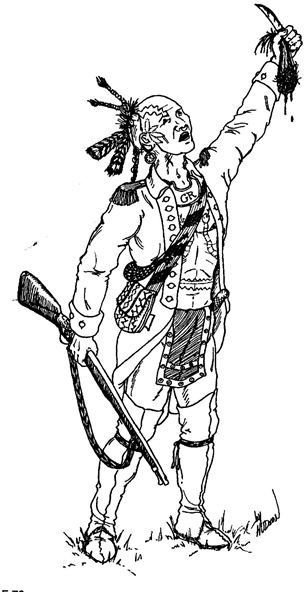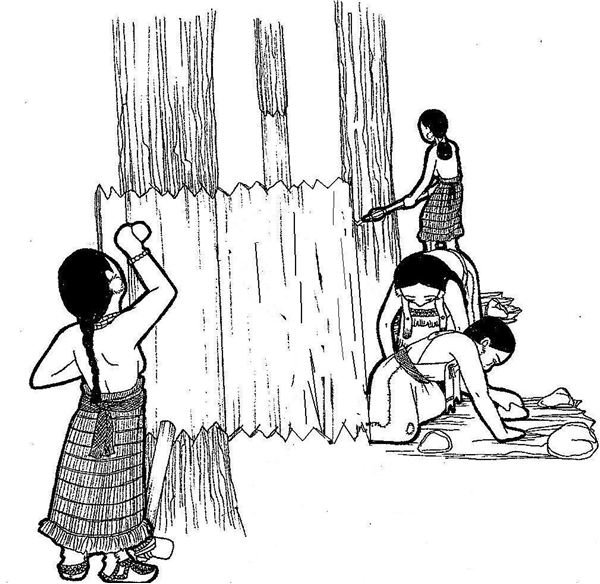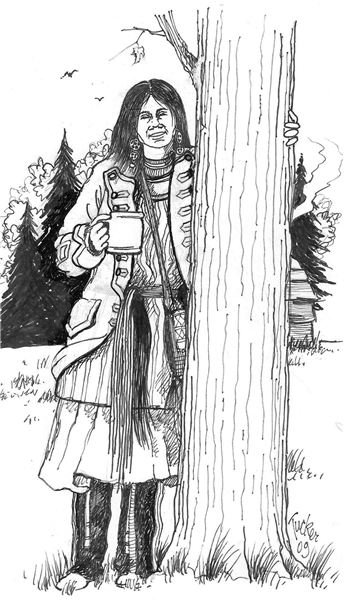Educating Students About False Stereotypes Regarding Native Americans: Lesson for Middle School or Above
Popular Images of Native Americans

1. Native Men were always in charge of the village. Wrong. Many female chiefs were often related to the men and had their own duties, sat on councils and were highly respected.
2. Most people think Native people always wore animal skin clothing. Wrong. Many Woodland Native cultures made very sophisticated tightly woven or “twined” plant fiber clothing before Europeans arrived. How do we know?
A. Pottery shards left by Mississippian peoples reveal the use of textiles pressed into the wet pottery
B. Early explorers left journals of their observations of people making cordage, mats, capes, and clothing –some said it was better quality than European
C. Archaeological evidence- pieces of woven materials found as far back as 10,000 years ago, some Hopewell samples are so finely woven, the experts are still amazed by the delicate techniques
D. Missionaries lived among the Natives in the 18th century and heard stories of ancestral use of twined skirts (Zeisburger, David, David Zeisberger’s History of the N. American Indians in 18th Century Ohio, New York, & Pennsylvania, 1999 Reprint)
3. All the Natives of the Ohio and Wabash used canoes for transportation. Wrong. The Miami apparently were not big canoe users. They referred to other people who did as, “canoe people.” Many of the rivers were full of rapids, falling water, snags of logs, and were not navigable with bark canoes. The only other choice was a dugout or pirogue, which was heavy and not easily transported on portages.
4. All Woodland Indians lived in tipis or wigwams. Wrong. By the mid-18th century, log cabins had begun to replace many traditional types of houses. Most of the 19th century villages in Ohio and Indiana were log cabin villages.
5. There were no villages in Kentucky or West Virginia because it was “hunting grounds.” Wrong. Early French maps clearly point out several distinct villages of Shawnee in both areas. The Shawnee inhabited this region on both sides of the Ohio River until driven out by the Iroquois. They slowly returned and occupied sites once again, but like their neighbors, the Miami, and the Lenape, they no longer had the populations to occupy all of their lands and white settlers were moving in on them from the south into Kentucky.
6. Probably one of the most notorious stereotypes that continue to haunt even modern Native Americans is the myth that all Indians were hostile and warlike. Wrong. Many of these people were sedentary people who had been largely consumed by agricutlural production. However, when their homes and lives are threatened, all people may resort to violence to stop attacks and threats. The settlers in the East and Ohio Valley who constantly complained about attacks from small bands of hostile Indians were the ones who were the squatters. The Natives fought back to protect and defend what had been their homeland for centuries.
Changing How Society Looks At Native Americans
**How can educators help students in understanding Native cultures in a new way with greater respect and sensitivity? Use the following ideas:
**
-
Look for books and educational materials that do not lump Native people under one term or description but separate them and offer explanations of customs by region; reinforce Native American tribal diversities.
-
Try to avoid dressing up at Halloween and Thanksgiving and using cartoonish looking Indian figures on walls and for decorations.
-
Help students to do research on contributions made to our culture today by Native Americans.
-
Do not equate the use of the term, “Indians” with things.
-
Avoid using negative terms as “redskins,” or “warriors,” as mascots or mottos.
-
Today, many Native Americans are not well informed as to the details of their own heritage and should not be expected to provide all the correct answers to age old questions.
-
Tell children that culture is “learned behavior” and that just because someone is “Native” or has Native blood, that does not mean they know what it was like to be Miami or Iroquois two or three hundred years ago. That information has to be researched because unfortunately much of the truth from the past has been lost to time.
-
Have children question images they see on television and movies, especially from the mid-20th century.
-
Remember that there are many Native people alive and thriving today, some out west and some right in the classroom who may or may not realize they have Native blood. Encourage students who think they have some “Indian” blood to go home and ask relatives about it and perhaps they can learn a little more about themselves and will encourage others to do the same.
-
Today, many people get impressions of Native Americans from gatherings called, “Pow Wow’s.” Unfortunately, this reinforces some of the stereotypes that all Natives do is dance, eat and go to war. Pow Wow’s are one of the few ways in which the public sees any reflection of Native culture. Go to Native gatherings, be respectful, but see if you can ask some questions and find out why they dance and ask them about the sacred drum and singers around the drum.
What are Stereotypes?
Discussion for Students
1. Have students add their own ideas regarding Native American culture and discuss those to see if they ring true or may be the product of another stereotype.
2. Ask students if there are things they have encountered in their own lives, prejudices, or ideas that would be considered stereotypes about themselves..
3. Why are stereotypes considered inappropriate or wrong?
4. Have students think of things that they could do to change old myths or stereotypes that are hurtful.
5. Does television and what is online have anything to do with promoting old negative myths about people?
6. Today, the image of the Native American has far less visibility than anytime in recent history. Books, television shows, websites, and movies are fewer in number that depict a good truthful story about Native people. Could stereotypes that have been around for years have contributed to this situation?
7. Some art critics and connoisseurs of classical architecture and art frown on the use of the term “art” and “architecture” when it comes to Native American culture. Why do think that is true and is there anything that can be done to change that old notion?
8. Images depicting warriors as hostile also may give viewers the idea that these people acted out their “savage” anger without any real debate went into whether it was warranted or not. Are there any good reasons for people to believe this? If not, explain.
9. Which of these images is more of a stereotype?
Why? What could you do to change it and make it more accurate?
Are there other pictures that could be added to illustrate how Native people really lived in the Woodlands?



References
- Photo of Bertha Parker by Smithsonian Institution from United States [see page for license], via Wikimedia Commons
- Mihesuah, Devon, American Indians: Stereotypes & Realities, Clarity Press, Inc. 2009
- Lubbers, Klaus, Born for Shade: Stereotypes of the Native American in United States Literature and the Visual Arts, 1776-1894 Rodopi, 1994